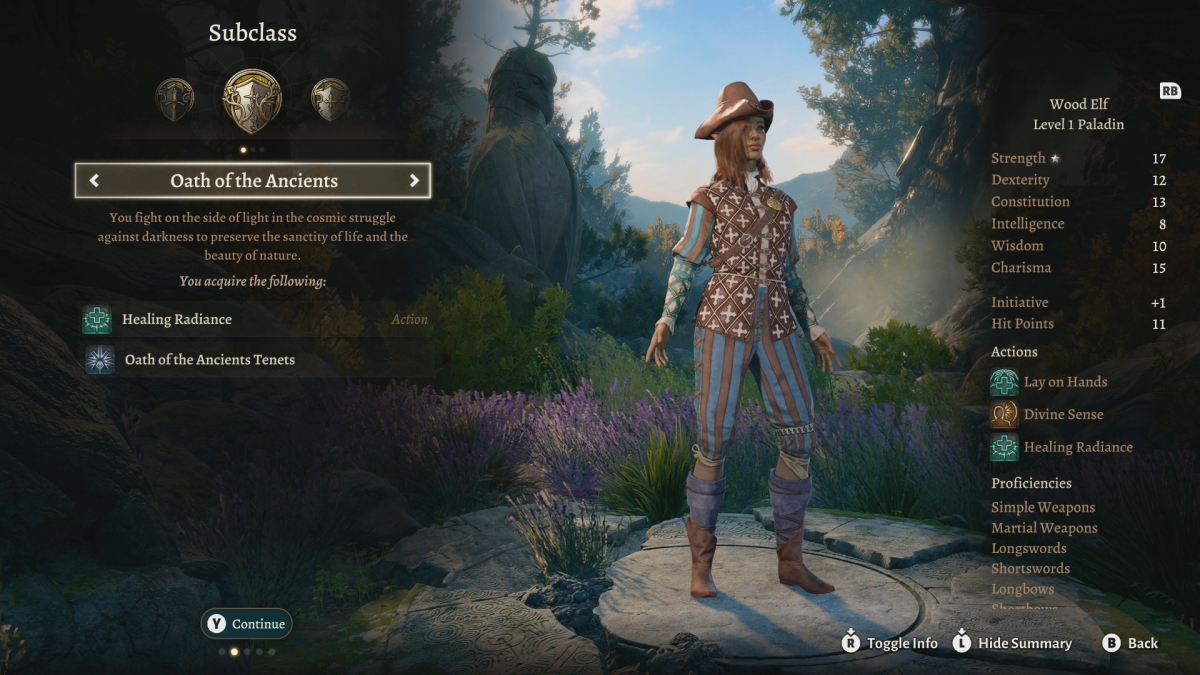When you play as a Paladin in Baldur’s Gate 3, you start by swearing one of three oaths that determine your subclass. The choices influence how you will develop at key points throughout the adventure. Here is our ranking of the best Paladin subclasses in Baldur’s Gate 3.
Note: You don’t have to limit yourself to one character class. If you would like, you can mix two or three of them. For more information, check out our guide explaining how to multiclass in Baldur’s Gate 3.
Baldur’s Gate 3 – best Paladin subclasses, ranked
When you choose a Paladin, you must swear an oath before you’ve even developed a feel for your character. Hopefully, you do have an idea whether you want to rely on might or magic, which should prove helpful as you choose your subclass. Take a moment to consider how you want to play, and then select the Paladin subclass that fits that style.
1. Oath of the Ancients (Best)
The Oath of the Ancients is for players who enjoy performing acts of kindness and preserving love and light. Choosing the subclass adds the Healing Radiance ability, which heals the character and nearby allies.
As this Paladin levels up, they gain numerous spells that allow them to perform their duties more effectively. Spells gained include Speak with Animals and Ensnaring Strike at level three, as well as Misty Step and Moonbeam at level five. At level seven, they learn Aura of Warding, which lessens magical damage allies receive. Level nine adds Protection from Energy and Plant Growth.
2. Oath of Vengeance (Good)
The Oath of Vengeance means showing no mercy for those who back an evil cause (I’ve noticed there are many such individuals in Baldur’s Gate 3). You tread the moral high road, and you’ll do your best to rid the world of those villains you have realized do not deserve life. The Inquisitor’s Might ability adds the ability to deal Radiant damage, and you can apply it either to your own weapon or to one carried by an ally.
At level three, you gain the Bane and Hunter’s Mark spells. Level five adds Hold Person and Misty Step. Then Relentless Avenger comes at level seven, and level nine imparts Haste and Protection from Energy.
3. Oath of Devotion (Okay)
The Oath of Devotion requires and rewards a head-on, fearless approach in order to maintain goodness. You don’t run from evil, because that just wouldn’t be right. Instead, you protect the weak from those who would crush them. The Holy Rebuke ability extends that oath to your party members. They will retaliate with Radiant damage when hit by an enemy’s melee attacks.
A Paladin of this subclass adds Protection from Evil and Good and Sanctuary at level three. These are both extremely helpful defensive spells that can keep an ally safe when they are facing powerful foes. At level five, the Paladin also learns Lesser Restoration (which eliminates a disease or condition) and Silence. Level seven brings about the Aura of Devotion to protect allies from becoming charmed. And at level nine, they gain Remove Curse and Beacon of Hope, which help out cursed comrades and improve positive effects they might receive.
4. Oathbreaker (Worst?)
If you want a Paladin with a dark heart, then the Oathbreaker subclass is the option for you. You can only activate the subclass by breaking an oath you swore initially. For instance, you might kill an innocent person or creature in Emerald Grove, early in the game. Or you might try your hand at a little necromancy. The actual misdeed required depends on which oath you swore.
A Paladin who follows the Oathbreaker’s path gains access to Hellish Rebuke and Inflict Wounds at level three, reflecting their tragic detour. They’re now consorting with the lost and the undead. The Crown of Madness and Darkness spells come along at level five, enabling the spread of moral corruption. These abilities make the Paladin a fearsome character that can be fun to play, as long as you don’t mind walking a darker path. If you change your mind and decide to fight on behalf of good once more, you’ll have to pay 2,000 gold to the Oathbreaker Knight to restore your original oath. It’s not a decision to be made lightly.
We’ve ranked the subclasses above, but any Paladin (Oathbreaker morally excepted) is a good option. Choose the subclass that best suits your style of play. And if you change your mind, check our guide on how to respec your characters with a little help from Withers.
Baldur’s Gate 3 is available on Steam.








Published: Aug 8, 2023 09:38 pm